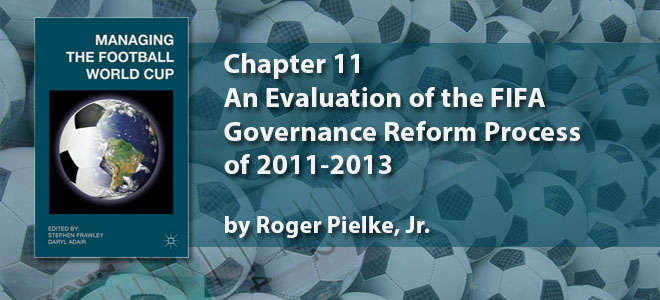by Roger Pielke, Jr.
Chapter 11 in Managing the Football World Cup
Edited by S. Frawley and D. Adair
Palgrave Macmillan, December 2014
At the October 2013 Congress of the Fédération Internationale de Football Association (FIFA) in Mauritius, FIFA President Sepp Blatter Declared that the governance reform process that he had initiated two years earlier had come to a close: ‘We have been through a difficult time. It has been a test for football and those who lead it. As your captain, I can say we have weathered the storm’ (Robinson, 2013). Blatter used the same nautical metaphor that he had upon launching the reform effort in May 2011: ‘I am the captain, we will weather the storm together’ (Pielke, 2013a).
The ‘storm’ that Blatter referred to involved an accumulation over the previous years of allegations of corruption and mismanagement at FIFA. The allegations which received the most attention involved the process used to select the 2018 and 2022 World Cup venues, chosen as Russia and Qatar respectively. In addition, the 2011 FIFA election, in which Blatter ultimately ran unopposed, was clouded by allegations of bribery and other shenanigans which ultimately led to the suspension of Mohammed bin Hammam, Blatter’s chief rival for the presidency, and his ultimate departure from FIFA altogether.
Of course, allegations of shenanigans and intrigue at FIFA have a rich history. In 1983, upon learning that the 1986 World Cup was assured to be awarded by FIFA to Mexico even before the process had been completed, Henry Kissinger is reported to have said” ‘The politics of FIFA, they make me nostalgic for the Middle East’ (Hughes, 2011). By 2011 the pressure on FIFA to respond in some manner to the mounting allegations became so great that the organization decided to embark upon institutional reform centered on the creation of what FIFA term an Independent Governance Committee (IGC).
In 2013, as the reform effort was concluding, Mark Pieth, a professor at the Basel Institute of Governance and the man hand-picked by Blatter to lead the FIFA IGC, said f the two-year effort: “in a relatively short space of time, it’s quite spectacular so far what has been achieved’ (FIFA Congress, 2013). As we will see, Pieth was not always so charitable in his views of the reform process. Perhaps predictably, FIFA announced that the process had been a resounding success: ‘the majority of the reform recommendations by the IGC were implemented’ (FIFA, 2013).
Such laudatory comments about the FIFA reform effort are difficult to reconcile with the perspective of other close observers. One member of the FIFA IGC, Alexandra Wrage, a governance expert and president of TRACE International, resigned from the committee just over a month before the 2013 FIFA Congress in Mauritius, explaining: ‘It’s been the least productive project I’ve ever been involved in. There’s no doubt about that’ (Panja, 2013). Following the Congress, Guido Tognoni, former FIFA Secretary General, told a Swiss television station: ‘Mark Pieth has good intentions but to me he’s like Sepp Blatter’s poodle. He must bark loud but he’s not allowed to bite. He had a promising approach but, of course, he’s banging his head against a block of granite’ (Bradley, 2013).
With such strongly voiced claims and counter-claims flying about, colored by interests, agendas and personalities, it can be difficult to get a sense of what was actually accomplished in the FIFA process in terms of institutional reform towards good governance. In order to provide a somewhat more objective basis for evaluation the process, this chapter conducts a formal evaluation of the FIFA reform effort under its IGC from 2011 to 2013.
The evaluation concludes that while FIFA did make some progress toward improved governance, such progress was limited, leaving considerable further reform necessary to bring the organization up to the standards of good governance that are widely accepted in business, government and non-profit settings. The chapter concludes with recommendations for how a governance reform effort might continue in a positive direction. Read more …


